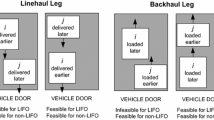Abstract
This paper will discuss the case study conducted to evaluate a logistics related policy (time between successive collections of commodities) that optimizes the total shifting cost and minimizes the transportation cost by considering the problem as a Dynamic Multi Capacitated Vehicle Routing Problem (DMCVRP). The DMCVRP is formulated and solved for various policies using Mixed Integer Linear Programming (MILP) with an objective to minimize the cost associated with the distance traveled by the vehicles and the cost associated with unutilized capacity in the vehicles. Finally, we approximate the total shifting cost as a single variable function of transportation, inspection and inventory carrying cost, which possesses continuous derivatives at every order with the single variable as time between successive collections and derive the necessary and sufficient conditions in locating the optimum (minimum) total shifting cost.
Similar content being viewed by others
References
Anily, S. and A. Federgruen. (1990), “One warehouse multiple retailer systems with vehicle routing costs.” Management Science, 36(1), 92–114.
Anily, S. and A. Federgruen. (1991), Rejoinder to “one warehouse multiple retailer systems with vehicle routing costs.” Management Science, 37(11): 1497–1499.
Anily, S. and Federgruen, A. (1993), “Two-echelon distribution systems with vehicle routing costs and central inventories,” Operations Research, 41(1), 37–47.
Anily, S. (1994), “The general multi-retailer EOQ problem with vehicle routing costs,” European Journal of Operations Research, 79, 451–473.
Bell, W. J., Dalberto, L.M. Fisher, M.L., GreenField, A.J., Jaikumar, R. Kedia, P, Mack, R.G and Prutzman, P.J. (1983), “Improving the Distribution of Industrial Gases with an On-line Computerized Routing and Scheduling Optimizer,” Interfaces 13, 4–23.
Burns, L. D., Hall, R.W. Blumenfeld, D.E. and Daganzo, C.F. (1985), “Distribution Strategies that Minimize Transportation and Inventory Costs,” Operations Research, 33(3), 469–490.
Carter, M.W., Farvolden, J.M., Laporte, G. and Xu, J. (1996), Solving an integrated logistics problem arising in grocery distribution, INFOR, 34(4), 290–306.
Chandra, P. (1993), “A Dynamic Distribution Model with Warehouse and Customer Replenishment Requirements,” Journal of Operations Research Societies, 44(7), 681–692.
Federgruen, A and Zipkin, P. (1984), “A combined vehicle routing and inventory allocation problem.” Operations Research, 32(5), 1019–1036.
Viswanathan, S. and Mathur, K. (1997), “Integrating Routing and Inventory Decisions in One-Warehouse Multiretailer Multiproduct Distribution Systems,” Management Science, 43(3), 294–312.
Qu, W. W., Bookbinder, J.H. and Iyogun, P. (1999), “An integrated inventory-transportation system with modified periodic policy for multiple products,” European Journal of Operations Research, 115, 254–269.
Author information
Authors and Affiliations
Corresponding author
Rights and permissions
About this article
Cite this article
Rajeshkumar, B.C., RameshBabu, T. Evaluation of logistics related policies between two different levels of the supply chain network—a case study. Ann Oper Res 143, 77–89 (2006). https://doi.org/10.1007/s10479-006-7373-2
Issue Date:
DOI: https://doi.org/10.1007/s10479-006-7373-2




